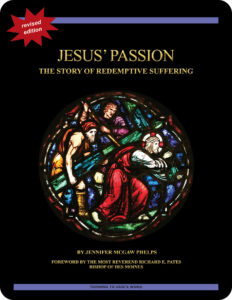 Jesus’ Passion:
Jesus’ Passion:
The Story of Redemptive Suffering
Lesson 1 Agony in the Garden
the Gospel According to Matthew 26:36–54
the Gospel According to John 18:1–14
Revised Standard Version Catholic Edition (RSVCE)*
New American Bible Revised Edition (NABRE)*
Catechism of the Catholic Church
Rosarium Virginis Mariae (Rosary of the Virgin Mary)
ex libris (in our library)
Salvifici Doloris (On the Christian Meaning of Human Suffering)
next lesson: The Son of Man Before the Chief Priests
This material coordinates with Lesson 1 on pages 9–14 in Jesus’ Passion: The Story of Redemptive Suffering. Click on the title of the study to access Lessons 1 through 5.
“For God so loved the world that he gave his only Son, that whoever believes in him should not perish but have eternal life.”—the Gospel According to John 3:16 (RSVCE)**
welcome to our annual Lenten Bible study
We invite readers to become acquainted with Turning to God’s Word Catholic Bible studies through  Jesus’ Passion: The Story of Redemptive Suffering, which was granted
Jesus’ Passion: The Story of Redemptive Suffering, which was granted  an imprimatur in 2014. In 2025, the free digital version of this popular Turning to God’s Word Catholic Bible study will be posted from Ash Wednesday, March 5, through Easter Sunday, April 20. If you have a question or comment about this or any other Turning to God’s Word Catholic Bible study, click on one of the “ask us your question” or “what do you think” buttons on any online study page.
an imprimatur in 2014. In 2025, the free digital version of this popular Turning to God’s Word Catholic Bible study will be posted from Ash Wednesday, March 5, through Easter Sunday, April 20. If you have a question or comment about this or any other Turning to God’s Word Catholic Bible study, click on one of the “ask us your question” or “what do you think” buttons on any online study page.
open with prayer
It’s always wise to begin any Bible study with prayer, whether reading the Scriptures alone or meeting with others in a discussion group. You can pray using your own words or use one of the opening prayers on our website. We especially like the following:
Lord Jesus, you promised to send your Holy Spirit to teach us all things.
As we read and study your word today,
allow it to touch our hearts and change our lives. Amen.
to coordinate with the movie
Lesson 1 coordinates with roughly the first 25 minutes of the film The Passion of the Christ. (See “Movie Notes” on page 9 in the Introduction For God So Loved the World to Jesus’ Passion: The Story of Redemptive Suffering for instructions about where to start and stop watching for this lesson.)
ex libris—a Lenten reading recommendation
 Jesus’ Passion: The Story of Redemptive Suffering relies heavily on Pope St. John Paul II’s
Jesus’ Passion: The Story of Redemptive Suffering relies heavily on Pope St. John Paul II’s  apostolic letter Salvifici Doloris (On the Christian Meaning of Human Suffering) to help explain the concept of suffering in our lives and the profound effect suffering plays in the life of Jesus Christ. The printed version of this powerful magisterial document, written in 1984, is only 23 pages long, but it’s packed with important spiritual truth. You can find links and excerpts from other magisterial documents referred to in Turning to God’s Word Catholic Bible studies at ex libris—magisterial documents.
apostolic letter Salvifici Doloris (On the Christian Meaning of Human Suffering) to help explain the concept of suffering in our lives and the profound effect suffering plays in the life of Jesus Christ. The printed version of this powerful magisterial document, written in 1984, is only 23 pages long, but it’s packed with important spiritual truth. You can find links and excerpts from other magisterial documents referred to in Turning to God’s Word Catholic Bible studies at ex libris—magisterial documents.
God communicates in a variety of ways
I first encountered Salvifici Doloris (On the Christian Meaning of Human Suffering) more than 30 years ago when i read a copy that I found at retreat house where I was spending a few days. When I returned home I promptly forgot all about it, but whenever something to do with suffering came up, I’d remember how much I’d liked this apostolic letter. Then I’d forget all about it again.
One of my friends—a woman who’s no stranger to suffering—was particularly interested in the Christian understanding of the redemptive value of suffering. I mentioned the pope’s document, and she asked that if I ever got around to buying a copy for myself, I pick up a copy for her as well. I agreed, but then I forgot all about it again.
something unusual happened
Several years later I was on vacation and happened to visit a large bookstore at a Catholic university. I was standing in front of a display of books, and one literally fell and landed at my feet. It was a somewhat freakish occurrence, since I wasn’t close enough to touch the display and no one else was nearby and could have bumped against it. A woman I didn’t know was in the vicinity, however, and she recognized that something unusual had happened. She looked at me and said: “I’d say you’re probably supposed to buy a copy of that.” I leaned over, picked up the little booklet that had landed at my feet, saw the title, and said to her: “No, I think I’m supposed to buy two.” And I did. I gave one copy to my friend, reread my copy, and put it on a shelf where—you guessed it—I promptly forgot all about it.
When I started writing Jesus’ Passion: The Story of Redemptive Suffering, I remembered Salvifici Doloris (On the Christian Meaning of Human Suffering). Pope St. John Paul II’s insights were extremely helpful as I was trying to make sense of the suffering portrayed in the film The Passion of the Christ. After I finished writing Jesus’ Passion: The Story of Redemptive Suffering, I put the document back on the shelf and forgot all about it yet again.
But whenever I’m asked to talk about Jesus’ Passion: The Story of Redemptive Suffering, I remember Salvifici Doloris (On the Christian Meaning of Human Suffering). Not everyone has to wait for a sign from God before learning what this document says. You can read it for yourself online right now. It makes an excellent accompaniment to Jesus’ Passion: The Story of Redemptive Suffering, but even if you’re not interested in the Bible study, Salvifici Doloris (On the Christian Meaning of Human Suffering) makes an appropriate choice for Lenten reading. Although it’s deep, it’s not excessively long.
 agony—you could look it up in our archives
agony—you could look it up in our archives
The first lesson in Jesus’ Passion: The Story of Redemptive Suffering focuses on Jesus’ agony in the Garden of Gethsemane. In Lost in Translation, Turning to God’s Word author Matthew Phelps helps readers connect with ideas expressed in the original languages of the Scriptures. You can learn more about how the Greek meaning of the word “agony” suggests a connection between Jesus’ struggles and an athletic competition. New Lost in Translation entries  are posted on Mondays, and past entries are archived on our website. Contact us if you’d like to receive Lost in Translation by email every week. You also may be interested in The Gospel According to John: An Encounter with Grace & Truth, especially Lesson 21 through Lesson 25, which deal with Jesus’ Passion, death, and Resurrection.
are posted on Mondays, and past entries are archived on our website. Contact us if you’d like to receive Lost in Translation by email every week. You also may be interested in The Gospel According to John: An Encounter with Grace & Truth, especially Lesson 21 through Lesson 25, which deal with Jesus’ Passion, death, and Resurrection.
my favorite scene from the movie
The section of The Passion of the Christ that inspired this lesson contains my favorite scene in which Jesus, who’s been praying in the Garden of Gethsemane, stomps on the serpent. This isn’t recorded in the Gospels, but it’s a clear reference to events surrounding the Fall of Adam and Eve in the Garden of Eden, described early in the book of Genesis. One thing that I found especially moving is that the actor Jim Caviezel portrays Jesus as a much stronger character than  many others who’ve attempted the role. The look that Jesus gives Satan before he crushes the serpent seems to say: “You worthless piece of garbage—bring it on.” Learn more in Lesson 3 The Fall of Adam & Eve in the Turning To God’s Word Catholic Bible study In the Beginning: The Book of Genesis.
many others who’ve attempted the role. The look that Jesus gives Satan before he crushes the serpent seems to say: “You worthless piece of garbage—bring it on.” Learn more in Lesson 3 The Fall of Adam & Eve in the Turning To God’s Word Catholic Bible study In the Beginning: The Book of Genesis.
who wouldn’t be tempted?
I can’t imagine a better representation of Jesus signing on for this contest with the forces of evil. That’s the primary message in Lesson 1 in Jesus’ Passion: The Story of Redemptive Suffering. Jesus’ agony represents his emotional and spiritual struggle with temptation. Temptation is something with which we humans are all too familiar. Jesus, who has a human will as well as a divine will, is tempted to skip the whole Savior-of-the-world gig. During his agony in the garden, Jesus firmly commits to see his Passion through to the end. You can read more about the link between the Garden of Gethsemane and the Garden of Eden in “Temptations in Two Gardens” on page 12 in Lesson 1 of Jesus’ Passion: The Story of Redemptive Suffering. Question 3 on page 10 deals with how the Church addresses a common misunderstanding about Jesus’ experience in the Garden of Gethsemane.
something I’m not too crazy about in the movie
Frankly, the demon flying at Judas in the scene beneath the bridge is a bit much for my taste. It’s an example of creative license used to portray something not found in the Scriptures. The intent undoubtedly is to show that Judas is a man hounded by demons. Well, OK—but I think that demon face jumping out of the mist comes across as contrived. You’re free to disagree with me and to side instead with filmmaker Mel Gibson, who clearly thought it was a great way to visually interpret the story.
about the movie notes
Many people who aren’t familiar with the Gospels—and some who are—get confused about which things depicted in the film are found in the Scriptures and which are embellishments. This new edition of Jesus’ Passion: The Story of Redemptive Suffering addresses those differences in the “Movie Notes,” which make it easier for you to identify what’s scriptural and what’s not. In case there’s any question, it’s probably a good idea to point out that this is a Catholic Bible study and not a study, critique, or commentary about the film The Passion of the Christ.
WHAT DO YOU THINK is the reason that you’re a Christian?
Have you ever thought about Christianity and asked yourself: “What’s in it for me?” This appears to be a flip question, but it’s at the root of why we become Christians. “Redemptive Suffering: What’s In It for Us” on page 5 in the Introduction For God So Loved the World to Jesus’ Passion: The Story of Redemptive Suffering provides answers directly from the Scriptures and the Catechism of the Catholic Church.
 ? How would you respond to a non-believer who’s asked you why you’re a Christian?
? How would you respond to a non-believer who’s asked you why you’re a Christian?
? What evidence can you point to in your life as proof of your faith in Jesus Christ?
? What’s your primary expectation related to your trust in Jesus?
ex libris—learn more about Jesus’ Passion, death & Resurrection

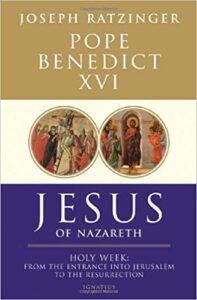 Jesus of Nazareth: Holy Week is one of three books in a series about Jesus in the Gospels. Written by Pope Benedict XVI, it looks at the decisive events that are the focus of Jesus’ last week on earth. The Scripture covered begins with Jesus’ entrance into Jerusalem and continues through the time of his Resurrection. Read excerpts and learn more about the Jesus of Nazareth trilogy and other works related to Bible study at ex libris—main bookshelf.
Jesus of Nazareth: Holy Week is one of three books in a series about Jesus in the Gospels. Written by Pope Benedict XVI, it looks at the decisive events that are the focus of Jesus’ last week on earth. The Scripture covered begins with Jesus’ entrance into Jerusalem and continues through the time of his Resurrection. Read excerpts and learn more about the Jesus of Nazareth trilogy and other works related to Bible study at ex libris—main bookshelf.
a study leader shares her thoughts
The following exchange veers from our standard question-and-answer format, but others may find it helpful. It comes from a study leader in a group planning to tackle one of our other studies.
 comment: Thank you for your online pages. They are such a bonus. In our Bible study more questions come up in our leaders’ group than in my individual group about why you ask a certain question, or what you might be thinking, or where you are leading with your questions. I’ve often been able to point to the online pages for direction and clues. I need to remind the other group leaders and myself that you’re trying to get us to think and pray about Scripture and its impact in our lives rather than limiting Bible study to an assignment that can be completed with a single academic answer.
comment: Thank you for your online pages. They are such a bonus. In our Bible study more questions come up in our leaders’ group than in my individual group about why you ask a certain question, or what you might be thinking, or where you are leading with your questions. I’ve often been able to point to the online pages for direction and clues. I need to remind the other group leaders and myself that you’re trying to get us to think and pray about Scripture and its impact in our lives rather than limiting Bible study to an assignment that can be completed with a single academic answer.
response: We appreciate your comments, especially since we know that the online pages are not everyone’s cup of tea. We go to some effort to provide optional supplemental information here and in the videos for participants who are interested.
Matthew, Tami, and I feel that it’s important for people to know that sometimes asking the right questions is more valuable than having all the answers. It took us at Turning to God’s Word some time to get to this idea. The bottom line is that no one is able to hold onto information that they’re spoon-fed the same way that they can remember and live it when they have to dig concepts out for themselves. This is a big departure from the popular scholarly model of Bible study where everyone expects an expert to tell them what stuff means, what’s important, and why. Sometimes when one of us sits in with a group, a participant will ask what we were going for with a particular question. People almost always find it shocking when they’re told that we were thinking we wouldn’t mind hearing a discussion about what others think about the passage in question.
Studying Scripture presents some special stumbling blocks. Some images and ideas in the Old Testament we might or might not recognize as also occurring in the New Testament. There’s a danger that we become so concerned with understanding the message as it originally would have been received, especially in the Old Testament, that we miss noticing that everything points toward Jesus. Then there’s the other side of that danger, in which we concentrate so much on a Christian interpretation that we miss important historical information that can shed light on Jesus and what he came to do. Finally, there’s a very real danger that we begin to view Jesus as the end point and miss seeing that the work of the Church only begins with Jesus’ death and Resurrection.
It’s easy to get derailed in one area and miss the big picture, which is why group discussion of the questions is helpful. If one person is focusing on Old Testament history, someone else may be looking at the way the writing points to Jesus. Another person may be concentrating on how these ancient books are relevant in today’s world. All these different points of view combine to give us a clearer picture of what God is saying to us in Scripture.
more about the online study pages & videos
We hope that some people will find Bible study so compelling that they’ll want more information than realistically fits in the study books. We want to provide a vehicle for extra material and an easy way for people to ask questions and make comments, especially with so many contradictory views floating around on the Internet and elsewhere.
It also is our intent that the books, the online study pages, and the videos each can stand alone if need be. We don’t want financial concerns or the lack of a compatible group to prevent anyone from reading and praying with the Bible. We know that there are people in our groups who never read the online pages or watch the videos, just as there are people who do all of those things and more. The only really necessary part of studying the Bible, however, is reading the Bible. Everything else is secondary.
The caution we would add is that if you’re limiting your Bible study experience to reading the Bible—and  you’re aware that you don’t understand what you’re reading—you probably should take a
you’re aware that you don’t understand what you’re reading—you probably should take a  look at our online commentaries and listen to any related videos. Turning to God’s Word author Matthew Phelps frequently addresses some of the more obvious difficulties in those places. If you’ve read all of our related commentaries and watched our related videos and still have questions, shoot us an email. We’re always happy to discuss Scripture, and some of our most cherished insights have come about in conversation with others.
look at our online commentaries and listen to any related videos. Turning to God’s Word author Matthew Phelps frequently addresses some of the more obvious difficulties in those places. If you’ve read all of our related commentaries and watched our related videos and still have questions, shoot us an email. We’re always happy to discuss Scripture, and some of our most cherished insights have come about in conversation with others.
visual meditation is a form of prayer
If you like to draw, consider illustrating your prayers for Jesus’ Passion: The Story of 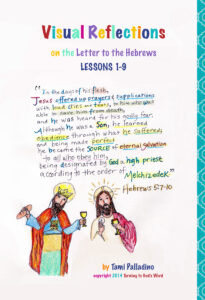
 Redemptive Suffering. Check out the visual-meditation journal of Turning to God’s Word co-founder Tami Palladino, which she created to accompany The Letter to the Hebrews: An Explanation of the Mechanism of Our Salvation. Tami also illustrated Sing a New Psalm: Communicating with God Through the Prayers of the Church—Volume I: Lauds & Vespers and The Revelation of Jesus Christ: The Faithful Witness, and some lessons in You Shall Have No Other Gods: The Book of Exodus and In the Beginning: The Book of Genesis.
Redemptive Suffering. Check out the visual-meditation journal of Turning to God’s Word co-founder Tami Palladino, which she created to accompany The Letter to the Hebrews: An Explanation of the Mechanism of Our Salvation. Tami also illustrated Sing a New Psalm: Communicating with God Through the Prayers of the Church—Volume I: Lauds & Vespers and The Revelation of Jesus Christ: The Faithful Witness, and some lessons in You Shall Have No Other Gods: The Book of Exodus and In the Beginning: The Book of Genesis.
the best Catholic commentary about Scripture
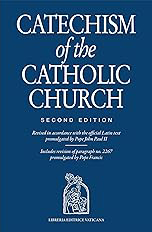 To find out more about how Church teaching is supported by Scripture passages in Jesus’ Passion: The Story of Redemptive Suffering, check out the Index of Citations in the Catechism of the Catholic Church. Links to the primary Scripture passages in the lesson (Revised Standard Version Catholic Edition [RSVCE*]) and relevant paragraphs in the Catechism are provided here. Not every passage in the biblical text for this Catholic Bible study is referenced in a Catechism paragraph, however.
To find out more about how Church teaching is supported by Scripture passages in Jesus’ Passion: The Story of Redemptive Suffering, check out the Index of Citations in the Catechism of the Catholic Church. Links to the primary Scripture passages in the lesson (Revised Standard Version Catholic Edition [RSVCE*]) and relevant paragraphs in the Catechism are provided here. Not every passage in the biblical text for this Catholic Bible study is referenced in a Catechism paragraph, however.
the Gospel According to Matthew 26:36–44—paragraph 2849
the Gospel According to Matthew 26:38—paragraph 363
the Gospel According to Matthew 26:39—paragraphs 536, 612
the Gospel According to Matthew 26:40—paragraph 2719
the Gospel According to Matthew 26:41—paragraphs 2733, 2846
the Gospel According to Matthew 26:42—paragraph 612
the Gospel According to Matthew 26:52—paragraph 2262
the Gospel According to Matthew 26:53—paragraphs 333, 609
the Gospel According to Matthew 26:54—paragraph 600
the Gospel According to John 18:4–6—paragraph 609
the Gospel According to John 18:11—paragraph 607
the Gospel According to John 18:12—paragraph 574
don’t forget about our indexes & extra online material

 If you’re trying to locate information about a Scripture passage, you can look it up in the index at the back of the online version of this study. If you want to revisit a commentary, you can look it up by title in the topics index. If you want to learn more about another book of the Bible for which there’s a Turning to God’s Word study, you can read online commentaries and watch any accompanying videos by choosing a lesson from one of the study directories. (There are no lesson videos with Jesus’ Passion: The Story of Redemptive Suffering.) Finally, if you have a question or would like to make a comment about any of our studies, you can use the “ask us your question” or “what do you think” button to email our authors.
If you’re trying to locate information about a Scripture passage, you can look it up in the index at the back of the online version of this study. If you want to revisit a commentary, you can look it up by title in the topics index. If you want to learn more about another book of the Bible for which there’s a Turning to God’s Word study, you can read online commentaries and watch any accompanying videos by choosing a lesson from one of the study directories. (There are no lesson videos with Jesus’ Passion: The Story of Redemptive Suffering.) Finally, if you have a question or would like to make a comment about any of our studies, you can use the “ask us your question” or “what do you think” button to email our authors.
ex libris—Church documents & books about religious topics
Link to magisterial documents referred to in our Bible studies at ex libris—magisterial documents.  This listing includes significant recent encyclicals as well as a number of historical Church documents. Recommended books related to Scripture study can be found at ex libris—main bookshelf.
This listing includes significant recent encyclicals as well as a number of historical Church documents. Recommended books related to Scripture study can be found at ex libris—main bookshelf.
memorize a favorite Bible verse (4:48)
Turning to God’s Word co-founder Tami Palladino has created a short video about the benefits of memorizing Bible verses. Choosing a passage that you find particularly meaningful will make the task easier. There are inspiring verses in every book of the Bible, but some people in our Turning to God’s Word Catholic Bible studies like to memorize a verse from their lesson every week. For more ideas, check out Tami’s video, Why Memorize Scripture? It’s less than five minutes long.
wondering how to pronounce some of these words?
The following links are to readings from the New International Version (NIV) Bible. To listen, click on the audio icon above the printed text. Although not taken from the translations used in our study materials, the NIV readings provide an audio guide to pronunciation of words in this lesson’s primary biblical texts. A close online version of the translation of the Bible used in Catholic liturgy in the United States as well as an audio guide for daily Mass readings for the current month can be found on the website of the United States Conference of Catholic Bishops (USCCB).
the Gospel According to Matthew 26:36–54 (NIV)
the Gospel According to John 18:1–14 (NIV)
close with Bible-based prayer related to this lesson
 Many groups conclude with a prayer based on Scripture, and some participants include Scripture-specific prayer in their individual study. If you’re uncomfortable composing your own Bible-based prayers, you can follow our four easy steps. If you prefer, you can use the following prayer based on the primary biblical texts that accompany this lesson in Jesus’ Passion: The Story of Redemptive Suffering.
Many groups conclude with a prayer based on Scripture, and some participants include Scripture-specific prayer in their individual study. If you’re uncomfortable composing your own Bible-based prayers, you can follow our four easy steps. If you prefer, you can use the following prayer based on the primary biblical texts that accompany this lesson in Jesus’ Passion: The Story of Redemptive Suffering.
O God, your Son Jesus willingly accepted
betrayal by his friend and the suffering it set in motion.
Give us the humility to appeal to your goodness in faith and trust
when the powers of evil tempt us to disobey your commands.
We ask this in union with the Holy Spirit
and in the name of Jesus,
who fulfilled your promises foretold in Scripture. Amen.
 coming up in the next lesson
coming up in the next lesson
The online study page for Lesson 2 The Son of Man Before the Chief Priests in Jesus’ Passion: The Story of Redemptive Suffering contains additional commentary, questions, and links to related material. The lesson roughly corresponds to the second 25 minutes of the film The Passion of the Christ. Links to the free digital version of the study will remain posted through Lent this year, and all of the lessons will be available again during Lent in 2025.
Lesson 2 The Son of Man Before the Chief Priests—the Gospel According to Mark 14:53–65, the Gospel According to Matthew 27:3–7, the Gospel According to John 18:12–38, and the Gospel According to Luke 23:1–12
Introduction For God So Loved the World
you also may like our study of Scripture & the Rosary (digital only)
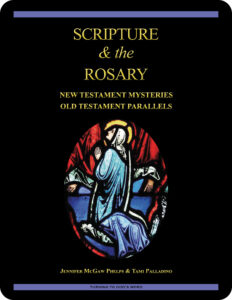 Scripture & the Rosary: New Testament Mysteries, Old Testament Parallels, a 26-lesson Catholic Bible study with an imprimatur, looks at the biblical foundations of the Rosary. The study includes lessons on Pope St. John Paul II’s Rosarium Virginis Mariae (Rosary of the Virgin Mary), the Apostles’ Creed, and the Luminous Mysteries as well as the original 15 Mysteries of the Rosary. Color photographs of stained glass windows depict key scenes in the lives of Jesus and Mary. Free digital lessons rotate throughout the year on our website.
Scripture & the Rosary: New Testament Mysteries, Old Testament Parallels, a 26-lesson Catholic Bible study with an imprimatur, looks at the biblical foundations of the Rosary. The study includes lessons on Pope St. John Paul II’s Rosarium Virginis Mariae (Rosary of the Virgin Mary), the Apostles’ Creed, and the Luminous Mysteries as well as the original 15 Mysteries of the Rosary. Color photographs of stained glass windows depict key scenes in the lives of Jesus and Mary. Free digital lessons rotate throughout the year on our website.
start a Turning to God’s Word Bible study
Thank you for your interest in Jesus’ Passion: The Story of Redemptive Suffering,  our annual free Lenten
our annual free Lenten  Bible study. Lessons can be downloaded from our website through Easter. Information about beginning a group study can be found at start a Bible study. Tami, Matthew, and I are available to answer questions about the Turning to God’s Word method of Catholic Bible study. You may use this email to contact us directly if you’re interested in starting another Turning to God study or in having your study schedule listed with other TtGW study groups on our website. —Jennifer
Bible study. Lessons can be downloaded from our website through Easter. Information about beginning a group study can be found at start a Bible study. Tami, Matthew, and I are available to answer questions about the Turning to God’s Word method of Catholic Bible study. You may use this email to contact us directly if you’re interested in starting another Turning to God study or in having your study schedule listed with other TtGW study groups on our website. —Jennifer
*There are seven deuterocanonical books in the Old Testament—the Books of Tobit, Judith, Wisdom, Sirach, Baruch, and First and Second Maccabees, as well as some passages in the Books of Esther and Daniel. Protestants usually refer to these works as “apocryphal,” a word that means “outside the (Protestant) canon” because they’re excluded from most Protestant Bibles. The word “deuterocanonical” means “second canon”; Catholics use that word to refer to any section of the Catholic Old Testament for which there are no extant, or existing, Hebrew manuscripts. All of the deuterocanonical books appear in the Septuagint, the earliest remaining versions of which date to the 1st century B.C. This Greek translation of the Old Testament was in common use by Jews at the time of Jesus. Learn more by reading How Do Catholic & Protestant Bibles Differ?
Turning to God’s Word printed Bible studies use the 2006 Revised Standard Version Second Catholic Edition (RSV2CE) translation for all Scripture references except those to the Psalms, which are taken from The Abbey Psalms and Canticles, prepared by the Benedictine monks of Conception Abbey and published in 2020 by the United States Conference of Catholic Bishops (USCCB). All Scripture links for the digital version of Jesus’ Passion: The Story of Redemptive Suffering are to the 1966 Revised Standard Version Catholic Edition (RSVCE) translation. The New International Version (NIV) audio recordings follow the same chapter and verse numbering as the RSV Catholic translations, but the NIV translation doesn’t include the deuterocanonical books and passages.
The 1966 RSVCE uses archaic pronouns and verb forms such as “thee,” “thou,” “didst” in the Psalms and in direct quotations attributed to God. The 2006 RSV2CE replaces these with more accessible English. The few significant translation changes in the RSV2CE include rendering almah as “virgin” in the Book of Isaiah 7:14 and restoring the term “begotten” in the Gospel According to John 3:16.
Numbering varies for some passages in this Bible study. Turning to God’s Word studies follow the numbering in the Revised Standard Version Catholic translations (RSV2CE and RSVCE). Discrepancies in the New American Bible Revised Edition (NABRE) are noted in the Index of Scripture Citations.
 You can learn more about the Psalms by viewing a sample lesson from the Turning to God’s Word Catholic Bible study Sing a New Psalm: Communicating with God Through the Prayers of the Church—Volume I: Lauds & Vespers. The second part of that study, Sing a New Psalm: Communicating with God Through the Prayers of the Church—Volume II: Vigils, Day Prayer & Compline, is scheduled for publication in 2025. Some verse numbers may vary in different translations of the Psalms.
You can learn more about the Psalms by viewing a sample lesson from the Turning to God’s Word Catholic Bible study Sing a New Psalm: Communicating with God Through the Prayers of the Church—Volume I: Lauds & Vespers. The second part of that study, Sing a New Psalm: Communicating with God Through the Prayers of the Church—Volume II: Vigils, Day Prayer & Compline, is scheduled for publication in 2025. Some verse numbers may vary in different translations of the Psalms.
**The Gospel According to John 3:16 (RSV2CE) reads: “For God so loved the world that he gave his only-begotten Son, that whoever believes in him should not perish but have eternal life.”
